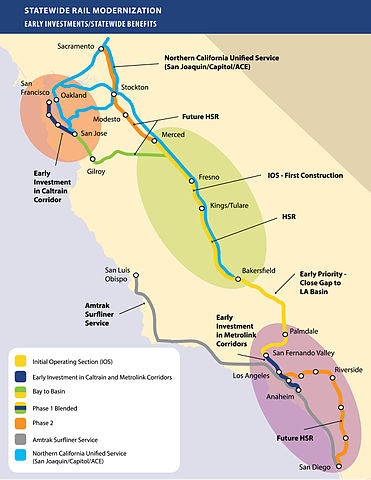With a population of 40 million people and growing, and major road-based transportation-corridor traffic often at a standstill, the prospect of riding a 220-mile-per-hour bullet train across much of the state, sounds extremely appealing. Though the question remains, is this the train Californians will get? One day, hopefully, it is!
Object of deserved or unfair criticism?
The high-speed rail project, once completed, will undoubtedly bring much-needed relief, though there are those who may disagree. California, if it were an independent country, would have the world’s 5th largest economy. On the world stage, the Golden State adds enormous amounts of greenhouse gases (GHG) to the atmosphere. Once again, if an independent country, in terms of global GHG-emissions output, California would rank number 20.
The state is saddled with problems of air pollution too. Los Angeles, along with central San Joaquin Valley cities, year after year in the U.S., top the lists as worst in the nation for ozone and both daily and annual PM 2.5 pollutant emissions (fine particles measuring less than 2.5 micrometers in diameter; to get some idea of PM 2.5’s size, the width of the average human hair is the same as that of the distance covered by 20 to 30 of these particles placed side by side) – tiny enough to enter the bloodstream or get lodged deep in the lungs. With electrified, high-speed, zero-emissions passenger trains running up and down the length of the Valley, in addition to portions of L.A., provided, of course, there exists sufficient patronage, such could bring considerable air-quality benefit.
Unfortunately, for those who take issue with the project for one reason or another, pretty much all of them, my guess is, want the project stopped.
Reasons for critics, detractors, naysayers calling for a California-high-speed-rail-building work stoppage, include construction-work progress being too slow-going; escalating costs and work-related cost overruns; oversight mismanagement; not to mention (if I have this right) factors related to what was specified in the original proposition, the one passed at the ballot box in 2008.
Despite such criticism leveled against the project, high-speed railroad-infrastructure-building since Jun. 16, 2015 (four-years’-worth) is moving steadily ahead.
Independent utility

Unless I’m wrong, should the project not be completed due to funding shortfalls, the parts that are completed, as long as these have what is referred to as “independent utility,” these can be utilized. This is exactly what we are seeing with the Bakersfield-to-Merced section currently under construction. Amtrak, for example, could be an interim operator of trains on the section in question.
Connecting and/or cross-platform provisions
Okay, so what to do in a situation where one needs to continue their journey beyond the station where high-speed trains terminate. This is where connecting services are crucially important.

Until such time that California’s state high-speed train is completely built out and is fully operational with all stations having a cross-platform provision (provided as a means to allow a connection with interconnecting passenger rail services), at number of stations, anyway, in the interim, connecting bus and/or shuttle and/or taxi will have to suffice.
In the Valley, with the exception of the Merced (union) station which should have service provided not only by high-speed rail but by presumably Altamont Corridor Express (ACE) through which a northbound high-speed passenger train patron can transfer to an ACE train destined to the Bay Area and vice versa (and, possibly as well, the Kings/Tulare regional station), in Bakersfield, Fresno and Madera, on the other hand, and again, presumably, all on-site available connecting transportation options will be fewer and may be limited to only those that are road-based – here again, bus and/or shuttle and/or taxi.
If this turns out to be the case, the downside is that more spaces for parking would be required compared to what, presumably, would be needed if available to arriving patrons were a connecting, so-called “forwarding” train. Not just this, but traffic in the vicinity is likely to negatively impact area streets in and around the station through the addition of more traffic. And, should the extra vehicles be powered by internal-combustion engines, more pollution pouring out of tailpipes would only serve to make local air quality worse.
Electric trains the mode choice of many
Air-quality-improvement-wise, if one is looking for air-quality benefit, electric train service all around, as far as I’m concerned, is the ideal way to go, an on-site electric-car rental option, notwithstanding.
In which case, the time to plan for the more preferable train-to-train connection option is now. One that may materialize is the Cross Valley Corridor that is in the discussion stage as I write this and if implemented, would serve the Kings/Tulare regional station.
There is more on this here.
Image above: California High-Speed Rail Authority (middle); Connor Harris (bottom)
This post was last revised on Jun. 7, 2020 @ 11:31 a.m. Pacific Daylight Time.
– Alan Kandel
